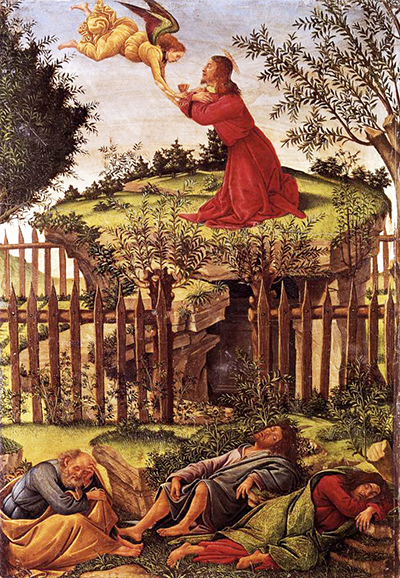Agony in the Garden was completed in circa 1500 by Italian artist Sandro Botticelli. The Florentine painter would produce a good variety of work across his career, including a number of religiously themed items as well as a plethora of traditional portraits.
The composition in front of us here features a figure kneeling down with his arms seemingly tied up. An angel floats down to help him, though he appears to be in great distress. The figure is dressed in a red full length outfit and is placed on a platform which is raised just above the rest of the painting. Below we find a number of figures who appear to be asleep or dead, and perhaps they had been attempting to free the entrapped man themselves, but unsuccessfully. There is a wooden fence between them which appears to have prevented them from coming to his aid. Alternatively, perhaps they were his guards, and have been put to sleep in order to allow the angel to come to his rescue - more understanding is needed to be sure about the content in front of us. Aside from these figures, there is also a good amount of plants and trees dotted around this scene.
The Agony in the Garden of Gethsemane is an episode from the life of Jesus Christ and has been used by many artists as inspiration for various paintings over the last few centuries. There are several different versions of this story but it relates to Christ praying whilst out walking in this garden. There are disciples with him who fall asleep, and these are represented with the figures in the bottom of this painting. There have been other interpretations by the likes of Andrea Mantegna, El Greco and Heinrich Hofmann, though the life of Christ in all has featured in many more oeuvres, particularlly in the Renaissance and Baroque eras when religion held a particularly strong influence on European society.
This painting can be found in the Capilla Real de Granada in Granada, Spain. This chapel is in the Isabelline style of architecture and was built in the early 16th century, shortly after Agony in the Garden was produced by Botticelli. They possess some really significant artworks from across Europe, including the likes of Rogier van der Weyden, Dirk Bouts, Perugino and Bartolomé Bermejo although the addition of Botticelli is certainly the highlight of their collection, given his reputation within Italian Renaissance art. There are also a number of famous people buried here too, including the Spanish monarchs, Queen Isabella I and King Ferdinand making it a venue with a wealth of historical interest, both in terms of the building itself as well as its contents.




